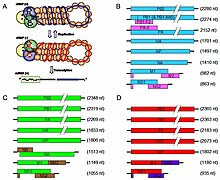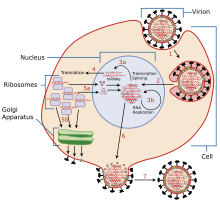Orthomyxoviridae
Orthomyxoviridae (from Ancient Greek ὀρθός (orthós) 'straight' and μύξα (mýxa) 'mucus')[1] is a family of negative-sense RNA viruses.
The four genera of Influenza virus that infect vertebrates, which are identified by antigenic differences in their nucleoprotein and matrix protein, are as follows: The influenzavirus virion is pleomorphic; the viral envelope can occur in spherical and filamentous forms.
[6] The viral envelope composed of a lipid bilayer membrane in which the glycoprotein spikes are anchored encloses the nucleocapsids; nucleoproteins of different size classes with a loop at each end; the arrangement within the virion is uncertain.
[citation needed] Viruses of the family Orthomyxoviridae contain six to eight segments of linear negative-sense single stranded RNA.
[9] In contrast, neuraminidase is an enzyme involved in the release of progeny virus from infected cells, by cleaving sugars that bind the mature viral particles.
The hemagglutinin (H) and neuraminidase (N) proteins are key targets for antibodies and antiviral drugs,[10][11] and they are used to classify the different serotypes of influenza A viruses, hence the H and N in H5N1.
[17] These proteins and vRNA form a complex that is transported into the cell nucleus, where the RNA-dependent RNA polymerase begins transcribing complementary positive-sense cRNA (Steps 3a and b).
Other viral proteins have multiple actions in the host cell, including degrading cellular mRNA and using the released nucleotides for vRNA synthesis and also inhibiting translation of host-cell mRNAs.
[19] Negative-sense vRNAs that form the genomes of future viruses, RNA-dependent RNA transcriptase, and other viral proteins are assembled into a virion.
[21] Once in the nucleus, the RNA Polymerase Protein PB2 finds a cellular pre-mRNA and binds to its 5′ capped end.
[26][27][28] Influenza A viruses are further classified, based on the viral surface proteins hemagglutinin (HA or H) and neuraminidase (NA or N).
It is thought that all influenza A viruses causing outbreaks or pandemics originate from wild aquatic birds.
[50] The influenza C virus infects humans and pigs, and can cause severe illness and local epidemics.
[54] This genus appears to be most closely related to Influenza C, from which it diverged several hundred years ago.
[57] Influenza viruses are susceptible to bleach, 70% ethanol, aldehydes, oxidizing agents, and quaternary ammonium compounds.
Because the antigenicities of the wild viruses evolve, vaccines are reformulated annually by updating the seed strains.
[citation needed] When the antigenicities of the seed strains and wild viruses do not match, vaccines fail to protect the vaccinees.
[citation needed] Drugs available for the treatment of influenza include Amantadine and Rimantadine, which inhibit the uncoating of virions by interfering with M2 proton channel, and Oseltamivir (marketed under the brand name Tamiflu), Zanamivir, and Peramivir, which inhibit the release of virions from infected cells by interfering with NA.






